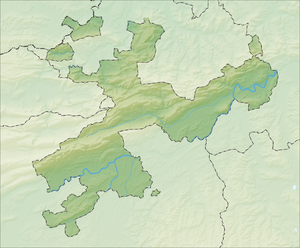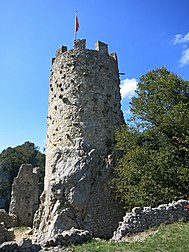Neu-Falkenstein ruins (Balsthal)
| New Falkenstein | ||
|---|---|---|
|
New Falkenstein |
||
| Creation time : | around 1100 | |
| Castle type : | Hilltop castle | |
| Conservation status: | ruin | |
| Place: | Balsthal | |
| Geographical location | 47 ° 19 '22 " N , 7 ° 42' 36" E | |
| Height: | 595 m above sea level M. | |
|
|
||
The Neu-Falkenstein ruin is one of the former castles in the municipality of Balsthal in the canton of Solothurn . It stands on the eastern ridge north of St. Wolfgang an der Klus to Mümliswil. Other castles in the region are Alt-Falkenstein , Alt-Bechburg and Neu-Bechburg .
investment
The ruin of the hill fort at 595 m above sea level. M. is divided into two core areas, a kennel and approach obstacles. The western core area is dominated by a round main tower, probably a keep . The oldest parts of the complex, the foundations of a trapezoidal residential wing, are in the eastern part. The remains of a chapel and several economic and residential buildings were also found. In the foreground are garden terraces and traces of a gun bastion from more recent times.
During excavations, at least four construction stages were proven, although no dating was possible in the outer bailey. The three other construction phases were determined to be in the 11th and 12th centuries, the end of the 13th century and around 1640. A second self-contained castle was built next to the castle of the first construction phase. The two castles were subsequently assembled. At an unspecified point in time, the access was expanded with a forecourt, a gatehouse and a kennel.
history
Despite its name, it is assumed that the castle is older than the Alt-Falkenstein castle on the other side of the valley . The castle was probably built in the early 12th century by a local noble family as the center of their rule. However, there are no precise archaeological references or historical sources. The brothers Welf and Ulrich von Falkenstein are mentioned in a document in 1145, the authenticity of which is doubted; whether they belonged to the founding family can therefore not be assumed with certainty.
Towards the end of the 12th century, the barons of Bechburg were named as the episcopal Basler fiefdoms of Neu-Falkenstein, but they never merged the complex with their own estates . The Bechbergers also had their castles in the area around Balsthal and thus controlled the southern access to the Upper Hauenstein.
In the early 13th century a branch of the Bechburger settled in Falkenstein and from then on called themselves Count von Falkenstein . During this time the castle was converted by her a large fortified palace added in Ostwerk and a new, circular keep was built.
The first proven owner of Neu-Falkenstein was Rudolf von Falkenstein, a son of Rudolf von Bechburg, in the second quarter of the 13th century. He was enfeoffed with the Buchsgau landscape by the Counts of Frohburg , who in addition to the Bishop of Basel had fiefdom over Falkenstein from 1374. Around 1250 he built Alt-Falkenstein Castle and the fortified outer bailey at the foot of the castle rock.
Before 1300, the castle changed from the Falkenstein family branch back to the Bechburg lineage. Until 1305 Neu-Falkenstein partly belonged to Rudolf III. von Wart, who was related to the Bechburgers. Rudolf von Wart was involved in the murder of King Albrecht I in 1308 and temporarily found refuge on Neu-Falkenstein. He sold his shares in the castle in 1309 to his cousins Heinrich and Markwart von Bechburg before he was captured and whacked.
In 1356, the castle was badly damaged in the Basel earthquake, which resulted in tedious repairs. This almost came close to a new building, which led to the misleading Neu-Falkenstein. Extensive repairs after the destruction in the Saffron War may also have contributed to this.
The saffron war

The Basel bishop Johann von Vienne (in office 1365-1381) had taken the help of Henmann von Bechburg in a war, but never compensated him. Since his demands were not taken into account, he attacked a transport of Basel merchants near St. Wolfgang in 1374 and captured, among other things, a considerable amount of precious saffron . This breach of the peace led to a 14-day siege by troops from Bern, 100 riflemen with a throwing machine from Basel, Landgrave Rudolf IV of Neuchâtel- Nidau , Count Hartmann III. von Neu-Kyburg and Count Sigmund II. von Thierstein -Farnsburg. After stubborn defense, the castle was captured and partially destroyed.
The nobles paid large amounts of compensation, and the sixteen mercenaries who had defended the castle were beheaded in the courtyard. The merchants did not get all of their saffron back: part of it was distributed among the victors to cover the costs of the war.
Henmann, the last Bechburger, was compensated for his earlier claims with 5800 guilders after his peace agreement with Basel and was able to have the damage repaired. But he got into financial difficulties elsewhere. In 1380 he pledged the castle to Rutschmann von Blauenstein and later found death in 1386 in the Battle of Sempach , whereupon Neu-Falkenstein fell to von Blauenstein.
After Henmann's death, his sister Margarete von Heidegg and the Counts of Thierstein, who had succeeded the Frohburger, also raised claims to the rule. In 1402 Hans von Blauenstein, who inherited Neu-Falkenstein from his father, sold his rights to the castle to the city of Solothurn . However, the city did not come into possession of the castle until 1417, after paying Margarete von Heidegg compensation of 500 guilders. The Thiersteiners waived their claims. The Bishop of Basel remained the supreme liege lord over Neu-Falkenstein until 1669.
To 1798 New Falkenstein was the seat of Solothurn bailiff the rule Falkenstein. The castle underwent various redesigns until it was set on fire during the Helvetic Revolution in July 1798 by the angry rural population under the leadership of Johann Brunner, the son of the Rössliwirt. The ruin was then left to its fate and fell apart.
In 1900, the company Tuesday took the ruins of Balsthal on and began the preservation of the ruins, where at first only the keep was restored. From 1938 to 1939, uncovering work was carried out on the ruin, which, however, was handled improperly; numerous finds were lost.
Observation tower
|
Lookout tower ruin Neu-Falkenstein
|
|||||
|---|---|---|---|---|---|
| Basic data | |||||
| Place: | Balsthal | ||||
| Canton: | Solothurn | ||||
| Country: | Switzerland | ||||
| Altitude : | 607 m | ||||
| Coordinates : | 620541 / 241358 | ||||
| Use: | Observation tower | ||||
| Accessibility: | Observation tower open to the public | ||||
| Tower data | |||||
| Construction time : | around 1100 | ||||
| Building material : | stone | ||||
| Total height : | 16.00 m | ||||
| Viewing platform: | 15.00 m | ||||
|
|||||
62 steps lead from the edge of the tower to the viewing platform at a height of 15 meters.
From this one looks over the village of Balsthal , the striking rock of the Holzflue, as well as various hills and valleys of the Jura .
literature
- Gottlieb Loertscher: The districts of Thal, Thierstein and Dorneck . In: Society for Swiss Art History (Ed.): The art monuments of the Canton of Solothurn . tape 3 . E. Birkhäuser & Cie., Basel 1957, ISBN 3-906131-35-1 , p. 66-70 .
- Bruno Amiet : The castles and palaces of the Canton of Solothurn . In: Schweizerischer Burgenverein (Ed.): The castles and palaces of Switzerland . tape III . E. Birkhäuser & Cie., Basel 1930.
- Werner Meyer : Castles from A to Z - Burgenlexikon der Regio . Published by the Castle Friends of both Basels on the occasion of their 50th anniversary. Klingental printing works, Basel 1981, pp. 209–213.
- Emil A. Erdin: Cantons of Basel-Stadt, Basel-Land, Solothurn, Neuchâtel, Jura and Laufental. In: Werner Meyer (Ed.): Castles of Switzerland . tape 7 . Silva-Verlag, Zurich 1981.
- Hans Sigrist: The barons of Bechburg and the Oberaargau . In: Yearbook of the Oberaargau . tape 3 . Schelbli + Co., Herzogenbuchsee 1960, p. 105–111 ( http://www.digibern.ch/jahrbuch_oberaargau/jahrbuch_1960/JBOAG_1960_105_111_freiherr_von_bechburg.pdf PDF 43.4 kB).
Web links
- Werner Meyer: New Falkenstein. In: Historical Lexicon of Switzerland .
- Castle world: Neu-Falkenstein
- Illustration by Daniel Meisner from 1625: Falckenstein. Then one thút, then he is lucky ( digitized version )
- Ibido videography drone flight from Neu-Falkenstein








